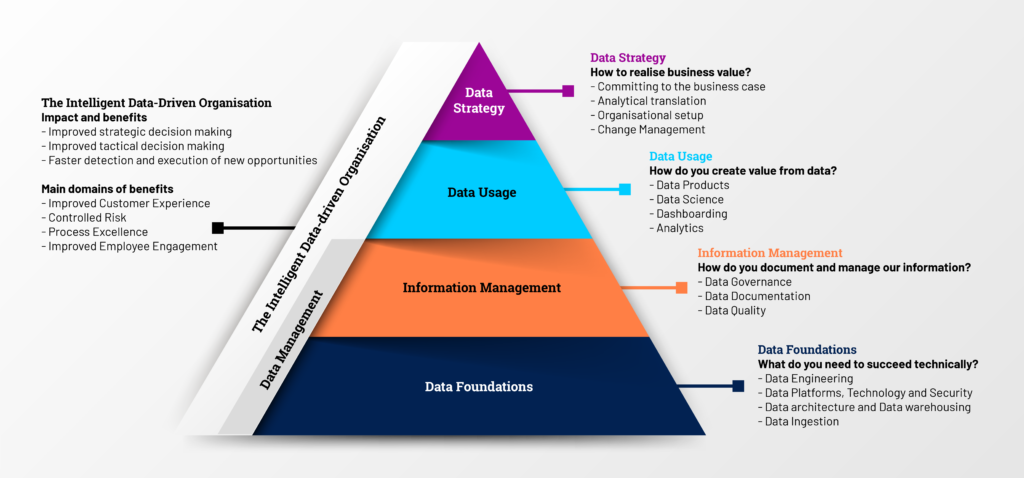Becoming more data-driven is high on the agenda of many organisations today. Among other benefits, data-driven organisations are considered 150% more likely to report a revenue growth of at least 10%. In recent years, many organisations have been excited about their success in applying artificial intelligence and smart algorithms in their processes and decision-making. However, building a data-driven organisation is quite something else than scoring a quick win in artificial intelligence.
In this short article, we’ll describe some of the crucial components that need to be in place to ensure that you can fully leverage the benefits of being data-driven:
- You can only create value by using data. Whether it is through intelligent algorithms or widely spread dashboards, data should supports better decisions and better processes.
- All of the above can only be realised if there are solid data foundations. In this way, companies ensure that data is made available in a timely and structured manner.
- A crucial, but often underexposed domain is information management. These activities ensure that data is used correctly, is well documented and of high quality.
- Finally, data strategy ensures that all investments are made in light of the creation of value and the realisation of business goals
But let’s first take a step back and look at the benefits of becoming more data driven
Benefit – Improved strategic decisions: one of the benefits of investing in data is making better strategic decisions. To develop a good strategy, it is wise to build on accurate data and solid insights. For example, data-driven segmentation can help an organisation improve its offering to strategic customer segments, and the evolution of these strategic segments can be represented in management dashboards.
Benefit – Faster and better tactical decisions: another advantage is that quick decisions can be made with great accuracy. Think of a bank that has to decide who is entitled to a loan. You can either use a small army of people to make this decision manually, or you can use an algorithm to do so. More and more companies are realising that algorithms are not only faster, but also less prone to cognitive bias, and thus lead to more accurate decisions (such as who gets a loan or who should be hired). When properly applied, these algorithms are implemented in smart automated processes that drive companies to make better and faster decisions at every step of their operations.
Benefit – Exploration of new opportunities: recent research shows that data-driven companies not only outperform their competitors in their traditional business activities, but they also tend to set up completely different activities where they have a competitive advantage (see e.g. here). Data-driven organisations excel in the speed of detection and execution of new opportunities.

The short track to results – data usage
Usage – Dashboarding: for a data-driven organisation, it is essential that more and more employees have access to the data they need to make wiser decisions. Many companies today are moving towards self-service Business Intelligence, which means providing access to tools like Tableau or Power BI to allow users to create their own dashboards. These dashboards typically contain clear and concise visualisations and – once created – can be easily refreshed as new data becomes available.
Usage – Analytics: in addition to dashboards, companies often employ several analysts in different business departments tackling basic to complex data questions (e.g. “what was the impact of the corona crisis on our organisation?”). These analysts often have good business acumen and knowledge of analytical tooling to answer the questions correctly.
Usage – Data Science: a major application in data science is predictive analytics (or in a more technical term: machine learning) – where companies deploy algorithms to turn knowledge from the past into accurate future predictions. For example, using sales patterns of historical purchases, organisations build algorithms to predict exactly which clients will buy which products. Other examples can involve anomaly detection (e.g. for fraud detection purposes), recommendation engines (for cross-selling the right product or service to the right customer), natural language processing (e.g. for routing emails to the right agents), computer vision, and so on. Data science in effect provides the intelligence in AI.
Usage – Data products: usage of data is not a one-off analytical exercise. When Netflix creates a recommendation engine to recommend series to its viewers, it should be put into production so that it is always generating relevant output. In that sense, the one-off analysis becomes a data product.
(Usage – Digital products): data products are sometimes integrated into full-blown digital products such as an API, a mobile app or a website. On some occasions, the data product suffices (consider a bank where the bankers receive the outcome of the credit evaluation), in other cases the digital product enforces the solution (consider a bank where clients can compute the outcome of their credit evaluations through their banking app).
What needs to be in place – Data Foundations. Data does not live in a vacuum. It needs to be organised to be deployed at scale.
- Data ingestion: companies collect data in different source systems (operational sources, CRM systems (e.g. sales force), ERP systems (e.g. SAP) and digital marketing solutions (e.g. Adobe). These sources provide a solid foundation for everything that will happen later. They can contain structured data (e.g. product usage) as well as unstructured data (e.g. customer emails) and can provide internal data as well as external data (open data or purchased proprietary data). Note that the most valuable data you have, tends to be the data in internal systems registering behavior of your own customers, processes and employees. This is because this data provides a competitive advantage: knowledge that only you possess about your clients, processes and employees. Structural processes should be created to organise the ingestion of data into the company’s systems.
- Data architecture and data warehousing: the data usually gets organised into a logical set of tables created in a structured way, so it can serve business purposes. An increasing number of companies today however chooses to store all data in a data lake, implying that no structure is imposed, but all data is just made available in a given storage environment, ideally complemented by a data catalog containing locations and metadata.
- Data platforms and technology: this data can be organised in on-premises data platforms as well as cloud platforms, such as AWS, Azure or Google Cloud Platform. Based on the needs of an organisation, choices are made ranging from traditional on-premises and Hadoop-cluster based on-premises to the cloud.
- Data security: whether organised locally or in the cloud, a major concern of any company should be to keep its data secure and protected.
- Data engineering: specific processes are created to move data from one system to another, from the sources to the data products. Today this is most often referred to as data engineering. Creating robust data pipelines between systems and organising data so that it’s ready for usage, is the job of a Data Engineer: an increasingly popular role in the data domain.
The growing need for Information Management: certain processes are needed to ensure that your available data is treated with respect. In most organisations, this area merits more attention. Mature data organisations are already leading the way.
- Data governance: a data-driven culture does not imply that anyone has access to any type of information. Instead, clear roles and rules are defined to establish the responsibilities and data access.
- Data documentation: Rule number one in any data driven organisation? Make sure employees are aligned on what data actually means. Organisations often engage in creating a business glossary, a lexicon of terms used by the business. For example: how do we define an “active client”? Lacking a business glossary, different departments may be lost in translation. Typically, data stewards are used to make the translation between a business domain and the data terms – and they will be responsible for creating the business glossary. Additionally, in order to understand where a specific data field comes from, mature companies organise data lineage – meaning they document which source produces which data field and how.
- Data quality: all companies have data quality problems. These problems are sometimes caused by people entering the data manually (e.g. sales people) or by faulty company processes. This means that data quality problems must be managed (using rules) and monitored (using KPIs). For example, a social security number has a specific number of digits and a certain structure. In this respect, companies need to organise data quality processes to monitor and correct data quality issues. This doesn’t necessarily mean that a company’s data needs to be 100% correct to create value. Most companies live with the fact that their data is not 100% accurate and strive towards improved performance on a daily basis.
- Data protection: a lot of this data is indeed sensitive. This aspect received much more attention since the implementation of GDPR in May 2018, where the rules for data protection are clearly mentioned. A crucial example of those rules is that people only need access to personal data if they really need it to fulfil their job. Restricting access by defining clear roles and rights is important in this respect. The DPO (Data Protection Officer) typically guides users to ensure that usage is in line with GDPR.
When done right, the data story is a story of connection between business skills, technical skills, analytical skills and legal skills
The lever to success – cultural change: for an organisation to realise the benefits of being data-driven, there is one main common pitfall: cultural change. Organisations that are used to making decisions using manual processes, will find it difficult to switch to algorithms and automated procedures. They will seek reasons not to engage in such activities for the sake of job protection or general reluctance to change. It is important to realise that the true benefits of being data-driven cannot be reached by ignoring that this requires cultural change.
This is where data strategy comes into play: realising that all components described before are needed to successfully become data-driven. And that the employees of a company are the key actors in making this happen. This implies involving a large group of employees with diverse and complementary skills – such as business skills, technical skills, analytical skills and even legal skills. When performed right, the transformation towards a data-driven culture is a transformation of connection and inclusion, and involves a large variety of roles and responsibilities. In a mature data-driven culture, no employee (and no member of the board) should be able to escape having a data-driven mindset.
Interested in discussing how we can help your organisation to become more data driven through (executive) training, transformation projects or even staffing? Contact us for more details.



